武吉布朗展览系列华语讲座
2014年9月20日(星期六)
地点:新加坡国家图书馆5楼,Possibility Room
2-3pm坟墓建筑(主讲者:赖启健博士)
3-4pm 说书的石头—武吉布朗坟场坟墓石雕中的故事(主讲者:洪毅瀚先生)
4-5pm 记录武吉布朗:地图与制图(主讲人:莫缕勇先生)
如欲出席讲座,请在下列网站登记:
http://www.eventbrite.com/e/bukit-brown-exhibition-public-talks-mandarin-tickets-12507206391
坟墓建筑
主讲者:赖启健博士
武吉布朗坟场的坟墓建筑是它独特物质文化的一部分,为新加坡和本区域以及中国南方之间在社会、文化和经济上的联系提供不少重要的资料。讲座将探讨武吉布朗坟墓建筑的记录和这项工作的重要性。主讲者也将利用纸模型让出席讲座的孩童对 坟墓健 筑有更深一层的认识。
赖启健博士,新加坡注册建筑师,新加坡国立大学建筑系硕士(1996),美国加州大学柏克莱建筑与都市设计系博士(2005)。他的研究领域为东南亚艺术、建筑、聚落、都市化和景观的历史。
说书的石头—武吉布朗坟场坟墓石雕中的故事
主讲者:洪毅瀚先生
武吉布朗坟场的坟墓石雕数量庞大、题材丰富,堪称海外华人坟场中的石雕大观园,早年精湛的手工石雕艺术作品随处可见。坟场内许多雕刻精美的石质坟墓构建丝毫不受岁月的洗礼损坏,让百年后的游人有机会一睹它们的风采。无论是江山美人、择贤用才、事亲尽孝或是神话志怪,流传千百年的民间故事和历史典故在石匠的巧手下生动地呈现。
这次讲座将通过大量的图片介绍石雕中的故事题材。
洪毅瀚,工程师,工余参与武吉布朗坟场导览活动和历史文化项目研究,曾在bukitbrown.com网站发表关于武吉布朗坟场坟墓装饰题材的博文。
记录武吉布朗:地图与制图
主讲人:莫缕勇先生
在记录武吉布朗文史的过程中,工作团队搜集到了不少非常珍贵和罕见的历史地图和空中照片。主讲人莫缕勇先生将在讲座中呈现这些历史地图和空中照片。同时也会分享一些地图和空中照片中有趣的细节。在另外一方面,由于坟场受到开路工程的影响,约有4000座坟墓需迁移。为了记录这些坟墓的确切位置,有关当局测量了每一座坟墓的地理坐标。主讲人也会讲解这一测量和绘制坟场地图的过程和结果。
莫缕勇是武吉布朗文史记录工作小组和工作委员会的成员。目前从事地理资讯系统(GIS)的咨询工作,也是地图发烧友及研究者。在武吉布朗文史记录团队里负责研究历史地图与处理地理资讯和绘制地图的工作。曾在新加坡制图单位任职和国家挡案馆工作,是伦敦皇家地理学会会士。
Public Talks in association with the Bukit Brown Exhibition (In Mandarin)
Saturday, 20 September 2014
2-3pm
Speaker: Dr Lai Chee Kien
Title: Tomb Architecture
3-4pm
Speaker: Ang Yik Han
Title: Story Telling Stones – Tales from the Stone Carvings of Bukit Brown Cemetery
4-5pm
Speaker: Mok Ly Yng
Title: Documenting Bukit Brown: Maps and Mapping
Please register your attendance at the following website if you are interested to attend these Mandarin talks:
http://www.eventbrite.com/e/bukit-brown-exhibition-public-talks-mandarin-tickets-12507206391
Tomb architecture
The material culture at Bukit Brown cemetery, including tomb architecture, is unique and offer many insights on Singapore’s social, cultural and economic connections to the region and to Southern China and Singapore. This talk discusses the documentation of tomb architecture at Bukit Brown and the importance of such records. There are also opportunities for children at this talk to learn about tomb architecture using paper models.
Dr Lai Chee Kien is a registered architect, and graduated from the National University of Singapore with an M Arch. by research [1996], and then a PhD in History of Architecture & Urban Design from the University of California, Berkeley [2005]. He researches on histories of art, architecture, settlements, urbanism and landscapes in Southeast Asia.
*******
Story Telling Stones – Tales from the Stone Carvings of Bukit Brown Cemetery
The large number and varied themes of stone carvings in Bukit Brown veritably make it a museum of stone carvings where masterpieces of the past can be encountered at every turn. Many of the intricately carved stone structures in the cemetery are untouched by the ravages of time, and visitors can still see them in their full glory a century after they were created. Be it themes of heroes and beauties, appointing wise officials, filial piety or the supernatural, folktales and historical stories which have been passed down for centuries come to life in the hands of skilled craftsmen. During this talk, numerous pictures will be used to introduce the themes found in the stone carving stories.
Ang Yik Han is an engineer by profession. He is involved in conducting tours in Bukit Brown Cemetery and historical and cultural research. His posts on the decorative motifs of tombs in Bukit Brown Cemetery have appeared on the All Things Bukit Brown website (bukitbrown.com).
*******
Documenting Bukit Brown: maps and mapping
This talk showcases the various historical maps and air photos which were collected during the Bukit Brown Cemetery Documentation Project. Interesting details from these maps and air photos will be highlighted. The process of surveying and mapping the affected graves as part of the documentation will also be covered. The potential uses of these maps and surveyed data will be briefly touched on.
Mok Ly Yng is a member of the Bukit Brown Cemetery Documentation Project team and the Working Committee. He researched and sourced for the historical and current maps of the Bukit Brown area for the project. He had worked in Mapping Unit and the National Archives of Singapore. He is a Fellow of the Royal Geographical Society of London. He researches the history of surveys and mapping of Singapore as a hobby.
The Descendants’ Stories – A Guided Walk at Bukit Brown (English)
Sunday 24 August’14 : 9 am – 11.30am
Meeting Place: Bukit Brown Gates at end of Lorong Halwa.
For those who have written in asking about when the next upcoming tours will be:
Please check this blog bukitbrown.com under events every week for upcoming guided walks. Blog posts should be up by Wednesday. Guided walks are dependent on volunteers schedules but we try our best to organise guided walks every weekend.
The fastest way to find out about upcoming guided walks is to join the Heritage Singapore Bukit Brown facebook group here . The guided walks are generated as event pages from this FB group and are always pinned on top of the page. Please note if you are using a mobile device to access the FB page, you have to click on the pinned posts to get details.
Thank you everyone who wrote in, our apologies, we are unable to respond individually.
******
To those who have registered and received confirmation, please meet by 9am. Just as you pass enter the Bukit Brown gates, on your left would be the LTA site office. This would be the gathering point of Sunday’s guided walk. See you!
This guided walk is now full.
_____
All Things Bukit Brown* is pleased to curate a new guided walk in conjunction with the exhibition “Bukit Brown: Documenting New Horizons of Knowledge”
About the Walk: News that a highway was to be built across Bukit Brown in 2011 led some descendants who had lost touch with their ancestral tombs to embark on a quest to find them. Some of those who were successful shared their stories of reconnecting with their ancestors and family oral history with the volunteers on the ground, called Brownies.
In this tour, Brownies will share stories recounted to them by descendants they have met and who have become friends. But the highlight of this guided walk is the descendants, who will share their stories first hand at the tombs of their ancestors.
Noreen Chan is the descendant of a long line of influential and wealthy “compradors” – the business relationship managers of the old banking regime. At the tomb of Chia Hood Theam, Noreen will recount stories of her maternal great-great grandfather’s frugality and contributions to women’s education from family oral traditions and historical records.
In Tiong Bahru, Singapore’s earliest housing estate, is a street named after Lim Liak (Leack). Lim Soon Hoe, a descendant of the 6th generation, will unravel the history of Lim Leack’s contributions to the mining industry in the region and his personal search for the family’s private burial grounds in a place today translated as “New Cemetery”.
The Brownies will reveal who is the inspiration behind Emily of the award- winning play “Emily of Emerald Hill” and share how a descendant “re-fengshui’ed” her great grandfather’s tomb upon discovery in 2012.
The guided walk will end at the largest family tomb cluster in Singapore, the “Ong Sam Leong” tomb cluster featured in the exhibition poster – the jewel in the crown of Bukit Brown due to its sheer size.
****
Disclaimer: By agreeing to take walking tours of Bukit Brown Cemetery, I understand and accept that I must be physically fit and able to do so.To the extent permissible by law, I agree to assume any and all risk of injury or bodily harm to myself and persons in my care (including child or ward) Please read if you are attending our guided walks for the first time, useful info on safety : Getting There/游览信息
*All Things Bukit Brown is the banner for a group of volunteers called “Brownies” who conduct regular weekend guided walks and do independent research on the heritage, habitat and history of Bukit Brown. To date, they have guided almost 12,000 people since they started their guided walks at the beginning of 2012.
As part of the exhibition, Bukit Brown: Documenting New Horizons of Knowledge, a series of English (Sun 17 Aug’ 14) and Mandarin ( Sat 20th Sept’14) Public Talks have been programmed by the documentation team under Dr. Hui Yew-Foong.
Location: Possibility Room on Level 5
(Look out for guided walks in English and Mandarin specially curated by All Things Bukit Brown to complement the exhibition/talk when you attend the talks,details to be posted later)
Date: Sunday 17th August (English) Registration here (through eventbrite)
2-3pm Speaker: Dr Hui Yew-Foong
Bukit Brown: Documenting New Horizons of Knowledge
3-4pm Speakers: Dr Natalie Pang and Dr Liew Kai Khiun
The Internet and Bukit Brown
4-5pm Speakers: Lim Chen Sian and Angela Goh
Digging Bukit Brown
5-6pm Speaker: Mok Ly Yng
Documenting Bukit Brown: Maps and Mapping
Saturday, 20 September 2014 (Mandarin) Registration here through eventbrite
2-3pm Speaker: Dr Lai Chee Kien
Tomb Architecture
3-4pm Speaker: Ang Yik Han
Story Telling Stones – Tales from the Stone Carvings of Bukit Brown Cemetery
4-5pm Speaker: Mok Ly Yng
Documenting Bukit Brown: Maps and Mapping
Selected Abstracts and Bios
Bukit Brown: Documenting New Horizons of Knowledge
This talk introduces the various findings that have emerged from the multi-disciplinary study of Bukit Brown Cemetery. The speaker will share highlights from oral history interviews, field documentation of graves and fieldwork studying rituals performed at Bukit Brown. At the same time, the talk will demonstrate how various techniques and technologies employed in the course of documentation has enhanced the collection of data.
Dr Hui Yew-Foong is Lead Researcher of the Bukit Brown Documentation Project. He is an anthropologist by training, and has conducted fieldwork in Indonesia, Malaysia, China, Hong Kong and the US. Prior to taking up the documentation of Bukit Brown Cemetery, he was involved in leading a group of volunteers to document Kwong Hou Sua Teochew Cemetery before it was fully exhumed. Dr Hui is the author of Strangers at Home: History and Subjectivity among the Chinese Communities of West Kalimantan, Indonesia.
Tomb architecture
The material culture at Bukit Brown cemetery, including tomb architecture, is unique and offer many insights on Singapore’s social, cultural and economic connections to the region and to Southern China and Singapore. This talk discusses the documentation of tomb architecture at Bukit Brown and the importance of such records. There are also opportunities for children at this talk to learn about tomb architecture using paper models.
Dr Lai Chee Kien is a registered architect, and graduated from the National University of Singapore with an M Arch. by research [1996], and then a PhD in History of Architecture & Urban Design from the University of California, Berkeley [2005]. He researches on histories of art, architecture, settlements, urbanism and landscapes in Southeast Asia.
National Day Celebrations@ Esplanade is here again with an exhibition :”Our Brick Estate” and a series of talks on Sunday 10th August’14
Venue: library@esplanade (Open Stage)
Sunday 10th August’14: Talks
3pm – 3.45 pm
Our Brick Estate by Lai Chee Kien (赖启健)
Our island-city’s early foundations were laid at a time when the building material industry flourished. Join architectural and urban historian Lai Chee Kien as he traces the history of our local brick industry, from the early colonial period when they were handmade, to their industrial production and extensive use during our early days of nation-building.
This talk will be accompanied by an exhibition of the same title for the month of August.
4.30-5.15pm
Grandfathers’Roads : Legacy of Our Pioneers by Raymond Goh
Raymond Goh has been studying the legacies behind famous roads that have been named after the revolutionaries, war heroes, and builders of Singapore. Join him as he shares interesting stories behind some of them. Raymond is a specialised heritage tour guide who conducts tours for schools, community clubs and societies.
6pm – 6.45pm
Once Upon a Yesterday by Alex Tan Tiong Hee
Share your comments and sentiments with Alex Tan as he navigates the nation’s past in Once Upon A Yesterday, an interactive story tracing some of the historical events significant to Singapore’s socio-political environment in the 1950s, as seen through the eyes of a young boy. Alex graduated in law and is a trustee of the Settlement of Dr Lim Boon Keng (1921) and a committee member of the Singapore Heritage Society.
Preamble : Hungry Ghost Festival
Saturday, 26th July was the eve of what is popularly known as the Hungry Ghost Festival, and less well known by its traditional name of Zhongyuan Jie, which in essence is also about honouring ancestors. It takes place at the start of the Chinese 7th lunar month, and it is when the gates of hell open and the spirits of dead are free to wander among the living for a month. To appease them, offerings and entertainment is laid out by descendants at their homes, but also by temples, business and clan associations. This year, the prediction was that hell’s gates will open at 11pm on the eve of the festival.
The Salvation Rituals
At Bukit Brown, devotees from the Taoist temple Xuan Jiang Dian (Heng Kang Tian ) conducted a “chao du” or “salvation rituals” – considered an act of compassion – specifically for the forgotten and lost spirits there.
This is the 3rd year in a row, Xuan Jiang Dian have done this, ever since in fact news of the building of the highway across Bukit Brown in 2011 was announced. Exhumations of the some 4.153 graves which are in the way of the highway are drawing to a close. So there was added interest in this year’s ritual which was covered by our national newspapers. The National Heritage Board (NHB) shared that a specially commissioned video on rites and rituals at Bukit Brown will be uploaded soon to you tube.
A First Hand Account of “chao du”
The ” chao du” ceremony which was witnessed also by Brownies and other well wishers, started at around 8.3opm . It consisted of the setting up of an altar table with offerings at the major junction of the 4 roads in Bukit Brown which leads to Blocks 1, 5, 4 and 3.
The Taoist priests from China, resplendent in their robes, chanted and walked several ceremonial rounds in the area calling upon lost spirits. There was something soothing in their chanting and the air was redolent with the scent of what must have been a hundred lighted joss sticks. Each participant carried 3 sticks each throughout the 40 minute long chanting.
There was a stillness in the air and the smoke and swish of the robes carried the movement of the night. It ended with the burning of paper offerings and just as quickly as it was set up, the devotees packed up and left, with the the candles planted still burning and the last vestiges of the paper offerings smouldering down to embers.
******
Photo Gallery :

Side View : Off site 3 tablets, set up by Xuan Jiang Dian at Bukit Merah Blk 123 for the wandering spirits of Kopi Sua aka Bukit Brown. [right] for animals killed during agricultural activity (prior to it becoming a cemetery)[centre] for wandering souls[left] for animals killed during construction works (photo and caption by Chua Ai Lin)
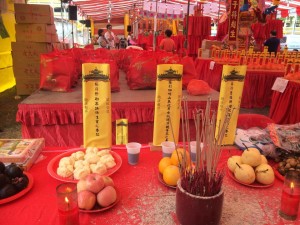
Front View : Off site 3 tablets, set up by Xuan Jiang Dian at Bukit Merah Blk 123 for the wandering spirits of Kopi Sua aka Bukit Brown. [right] for animals killed during agricultural activity (prior to it becoming a cemetery)[centre] for wandering souls [left] for animals killed during construction works (photo Raymond Goh)
Report on Lianhe Zaobao on a ritual conducted last night at Bt. Brown which marked the opening of the 7th month: A group from Heng Kang Tian including 8 Taoist priests conducted the ritual to invite spirits to a salvation ceremony conducted today in front of Bukit Merah View Block 123. The group has been going to Bt. Brown for the past two years to invite spirits from tombs which are not tended to by descendants. The event was attended by Brownies and participants of tours at the cemetery. It was also recorded by the Bt Brown Documentation Team. NHB is currently preparing a 10-15 min documentary on the rituals carried out at Bt Brown cemetery. This will be uploaded to the NHB channel on youtube, “yesterdaysg”, around end next month. (summary by Ang Yik Han) Full report in Chinese:
文物局到武吉布朗坟场 记录“招魂”仪式
王舒杨
联合早报2014年07月27日
今天是农历七月初一,华人传统节日“鬼节”今起开始。昨晚,武吉布朗坟场文史记录小组和国家文物局人员特地到武吉布朗坟场,记录一场由道教团体进行的祭祀仪式。
昨晚约9时,应道教宗教团体玄江殿邀请的八名道长和一名唢呐乐师在武吉布朗坟场进行“招魂”仪式。在道路两侧点亮“引魂”的香火后,他们在锣鼓声中唱诵经文。今明两天他们将在红山景第123座前的道场举行大型超度法会。
数十名积极参与保护武吉布朗文化遗产的公民团体成员也到场目睹仪式。除了这些“武吉布朗人”,不少报名参加坟场导览活动的外国人和游客也纷纷拿起相机拍下这个独具特色的活动。
玄江殿自1996年起多次在武吉布朗坟场举行农历十月初一的“寒衣节”祭祀活动,并从两年前开始在武吉布朗坟场举行七月鬼节的法事,目的是在坟场进行招魂,为他们超度。
根据武吉布朗坟场文史记录小组整理的资料,武吉布朗坟场里的中元节如同一项社区活动,是一种灵界上的慈善事业。信徒所祭祀的亡魂通常与他们没有任何亲属关系,尤其是孤魂。
玄江殿主持陈荣兴(45岁)说,武吉布朗一些坟墓主人没有子孙祭拜,所以希望能为这些孤魂超度。
此外,道家也相信所有生灵皆可超度,而坟墓挖掘过程中伤到蚂蚁等生灵,超度法事也怀有对它们的尊重。
国家文物局目前正在筹备一个10至15分钟长的纪录片,介绍华人社群在武吉布朗坟场的仪式,包括七月鬼节、清明节以及较少人知道的寒衣节。短片料下月底上载到文物局的YouTube频道“yesterdaysg”。
文物局总司长(政策)陈子宇说:“武吉布朗坟场不仅仅是一个埋葬地点,也是华人社群进行祭祖等仪式的地方。我们会记录这些仪式,以继续丰富我们有关新加坡非物质文化遗产的数据库。”
公众可通过在国家图书馆大厦9楼展出的“武吉布朗:记录新知识 开拓新视野”中英文展览,了解武吉布朗坟场上世纪的演变、坟墓设计和民间风俗等。图书馆大厦展览在10月10日结束后,将陆续在宏茂桥、裕廊、蔡厝港和大巴窑图书馆展出至明年1月底。
Register for our annual NDP Celebrations for 2014
Date 9 August, Time: 4pm – 7pm
Meeting place : Gates of Lorong Halwa, where we will begin by taking a group photo.
We have 3 Guided Walks which will all start at 4 pm at the gates
1 )Fabian and Simone will retrace the steps of men and women who broke traditions, defied the odds, dared fate and thereby defined an era and shaped the destinies of many
2) Bianca and Claire takes you on a poetic trail on the life and times of some Bukit Brown residents.
3) Mandarin Tour by Walter Lim, please click on link to register.
https://www.facebook.com/events/1446774978918007
The Brownies will lead you to the spot for collecting goody bags, and observing the National Anthem and The Pledge at the end of the guided walk. The programme after the walks will include quizzes and ad hoc singing, in conviviality and camaraderie.
NDP ’14 (Nations Deceased Pioneers) @ Bukit Brown this year honours the “can do” and caring spirit of our pioneers who helped to forge bonds which built the foundations for SG 50. It is the story of how “Our People” in Bukit Brown made Singapore, “Our Home”.
Please help us prevent wastage in preparing for food and ensure we have goody bags for everyone by registering here early so we can capture numbers early. Register by 6 August by clicking “join” . You may also register friends or family who are not on FB by leaving a comment on how many will be coming in this blog post.
FB registration here
If you are not on FB, you can register here by leaving a comment with your name if you would like to attend with your name and number of people who are coming with you.
————————–
Bring a torch light, as light will fade to night over the course of the celebrations. Please remember bring umbrella or poncho protect yourself against the sun with sunscreen and avoid donating blood to the mozzie brigade with.mosquito repellent.
We will celebrate regardless of rain, sun or exhumations
Disclaimer: By agreeing to take walking tours of Bukit Brown Cemetery, I understand and accept that I must be physically fit and able to do so.To the extent permissible by law, I agree to assume any and all risk of injury or bodily harm to myself and persons in my care (including child or ward) Please read if you are attending our guided walks for the first time, useful info on safety : Getting There/游览信息 If you have a facebook account please register on the FB links provided unless otherwise stated
Previous NDP reports :
Bukit Brown : Documenting New Horizons of Knowledge
Location: NLB 9th floor from now until 10 October’14 and thereafter it will travel to other regional libraries.
The exhibition was officially opened on Saturday 19 July,2014 by MOS (Ministry of National Development) Desmond Lee.
It represents almost one and half years of research and working the ground documenting some 4,153 tombstones which are affected by the building of a new highway across Bukit Brown, by a team under the leadership of Dr. Hui Yew-Foong, an anthropologist with ISEAS.
We have observed the team hard at work over these years, joined some of them during Qing Ming and exhumations as observers and friends of the family of descendants, and the exhibition is a comprehensive and compact expression of what they have uncovered, shared with the public with insight and interesting artefacts , enhanced by new technology. We recommend it as a “must see” and “ground breaking” for insights shared of customary practices and traditions of burial customs and respect for ancestors.
An extract from the media release:
Documenting New Horizons of Knowledge” assembles a diverse range of documents,maps, photographs and objects to demonstrate how a cemetery can open a window to Singapore’s historical past and cultural present. Through a multi-disciplinary approach employing cutting-edge methods, techniques and technology, the exhibition will bring to the fore new horizons of knowledge unveiled through the documentation of Bukit Brown.
The exhibition opens with the origins of the cemetery, as a project of the Municipal Commissioners in early 20th in 1973, will be illustrated through maps and aerial photographs. Next, through explication of tomb inscriptions, tomb typology and the material culture of the cemetery, the exhibition will demonstrate Singapore’s connectivity to the region, China and the world.
While the cemetery is a burial space for the dead, it is also a space for the living at different points of Singapore’s history and ritual calendar. This will be illustrated through the life of kampongs that used to be situated in the vicinity of the cemetery and the life of the cemetery during Qing Ming and the Seventh Month Hungry Ghost Festival.
As data for the graves was collected and organised within a Geographic Information System (GIS) framework, the exhibition will present a Centrepiece where visitors will be able to access data related to specific graves through a map-based database on a touch screen monitor.
Finally, visitors will get a glimpse behind the scenes of documentation work, to get a sense of the different methods, techniques and technologies that were employed in the course of documentation. These range from balloon photography to 3D scanning, from interviewing to filming, and from the work of architects to the work of archaeologists.
****
Highlights of the Exhibition Opening
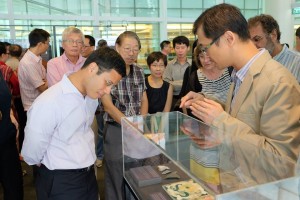
Dr Hui Yew-Foong, explaining material culture to MOS Desmond Lee during the curator’s walk through (photo Ang Hock Chuan)
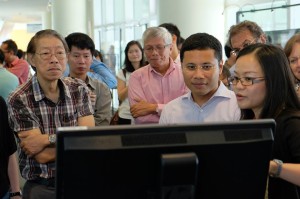
Dr. Natalie Pang (NTU) who worked on the IT applications for the centerpiece map demonstrating how it works to MOS Desmond Lee (photo Ang Hock Chuan)

The urn which used to house re-interred remains from other cemeteries to Bukit Brown (photo Raymond Goh)
This urn was used to re-inter bones exhumed from an older cemetery. It was from the grave of Madam Khoo Siok Hui, who died in 1836. Her grave was the oldest among those documented at Bukit Brown. Madam Khoo and her son Chee Yam Chuan were among the early settlers of Singapore. Mr Chee later returned to Malacca and made his fortune in tin mining in Selangor. Today, the Chee Yam Chuan Temple Trust continues to flourish in Malacca and Madam Khoo’s ancestral tablet can be found in the temple. The story behind this family shows the close links between Malacca and Singapore in the early years. It was Raymond Goh who first deciphered the inscription and unraveled the connection.

Treasure trove of jade bracelets worn by the women and traditionally buried with their wearers. (photo Ang Hock Chuan)
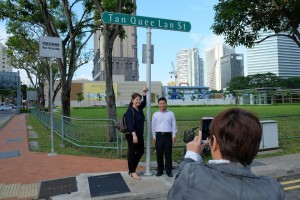
Descendant Serene Tan of pioneer Tan Quee Lan, gets one for the album when MOS Desmond Lee sportingly agrees to walk with her to visit her “great great grandfather’s road” ( photo Ang Hock Chuan)
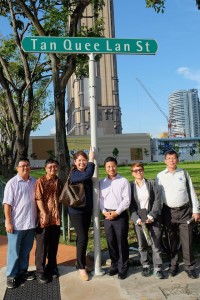
They were accompanied by a entourage of brownies who have been sharing Serene’s journey of reconnecting with her ancestors since Raymond Goh found the Tan Quee Lan cluster re-interred from another cemetery at Bukit Brown (photo Ang Hock Chuan)
A video at the exhibition features Serene Tan and her family observing the first Qing Ming at Bukit Brown in 2012 after Raymond Goh discovered the cluster of Tan Quee Lan tombs, and shows how the cluster underwent a renovation makeover by Serene and her cousin LT Tan who met at Bukit Brown itself. Serene’s story can be read here
The cluster is not affected by highway.
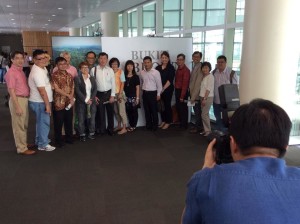
Brownies, academics, descendants, members of the documentation team at the exhibition (photo Khoo Ee Hoon)
“….to everyone who came and supported the launch, and most importantly, supported us and helped us generously with our research over the last 33 months. One of the purposes of the exhibition is to acknowledge all your contributions and I hope it accomplished that.” Dr Hui Yew- Foong, Curator of Exhibition on a FB posting.
Look out for 2 specially curated walks by the Brownies in conjunction with the exhibition in August (English) and September (Mandarin).
Photos taken of the exhibition courtesy of Brownie Ang Hock Chuan on Facebook here
Read more about the exhibition by the Rojak Librarian here
Disclaimer: By agreeing to take walking tours of Bukit Brown Cemetery, I understand and accept that I must be physically fit and able to do so.To the extent permissible by law, I agree to assume any and all risk of injury or bodily harm to myself and persons in my care (including child or ward) Please read if you are attending our guided walks for the first time, useful info on safety : Getting There/游览信息 If you have a facebook account please register on the FB links provided unless otherwise stated. There is also a walk by post museum in the after, please see details below for registration.
For all walks:
Please bring umbrella or poncho and sun protection.
Please wear covered footwear.
Please bring mosquito repellent.
Please bring sufficient drinking water.
Meeting place for all Walks : At the Lor Halwa Main gates at Bukit Brown
Sat 26 July’14 : 6.30pm – 8.30pm : A Journey into the Past with Andrew Lim
Follow Andrew for an evening stroll through Bukit Brown cemetery where he will share stories of the Past. We will go to a “mystery” location if time permits.
PLEASE BRING TORCH LIGHTS FOR THIS WALK
FB registration here
Mon 27 July’14: 9am – 11.30 am: Peranakan Tile Appreciation with Victor Lim
Join Victor Lim on his tour through the cemetery where he will focus on the various tiles used in the tomb designs.
Learn more about “Peranakan” or majolica tiles from our tiles expert!
FB registration here
Read more about the tiles here
by Joshua Ng
Instead of enjoying a quiet and uneventful Saturday, I chose to spend it at a live tomb measurement exercise. Armed with a trusty can of mosquito repellent, jeans and covered shoes, I arrived at the Bukit Brown Main Gate at 3.30pm. It was 35 degrees Celsius and I started to doubt my decision.
After a round of introductions, I was assigned to a team with Wei Ming (the drawing maestro), Andrew and Simone who are Brownies (volunteer guides). We had met briefly during the previous week’s theory and briefing workshop at NLB.
Our assigned tomb was Tan Ean Kiam’s wife, Ye Yan Niang (葉焉娘). Our task was to measure and draw the front view, section view and the plan view of the tomb.
Initially I was wondering why we needed four people to measure a tomb. It only made sense when we began our work. The curves, elevation and non-rectilinear structure makes it really hard to get an accurate reading. We had to use strings, bamboo sticks, IKEA flexible paper rulers, a metal tape measure as well as insect repellent to get it done.
The little insects that make their homes around the tomb were not amused — I even got a few ant bites on my hands. Some even crawled up my covered shoes and jeans and bit my calves.
Thankfully, after three hours of hard work, we finally finished our sketch. Our drawings were not the best. We committed at least one mistake, which was to assume that the sides are mirror images of each other. Chee Kien told us that we should not assume but measure and draw the tombs just as they are found. He pointed out that sometimes in a “couple” tomb, part of the tombs may be intentionally elevated so that the “water” will flow towards the descendants of one side.
This is not the first insight I gained from these two weeks of tomb measuring. I also learned that the different dialect groups have very different tomb designs. The one we measured clearly had a Hokkien design. Besides that, only the tombs in Bukit Brown have special bricks backing behind the head stone. It would have been very expensive to import bricks from China, so brick making was one of the earliest industries in Singapore.
As our assigned tomb was Tan Ean Kiam‘s wife, I figured he must have been some important person. I looked him up and found out that he was one of the founding members of OCBC Singapore. And he was also one of the founding members of the Tong Meng Hui (同盟会), which supported Sun Yet Sen’s revolutionary effort.
Another unique feature of this tomb is that the history of Mrs Tan was written by Tan Ean Kiam himself. According to the Brownies, Tan Ean Kiam’s own handwriting was inscribed on the body of the pedestal altar. Other than the fact that Tan Ean Kiam was alive when his wife passed away, we also know that he must have loved his wife a lot to do something so unusual as to personally inscribe her life story.
What amazed me the most is the fact that such a simple exercise like tomb measuring could connect the dots in my understanding of those who went before me. It makes me wonder what interesting facts I can discover from my grandparents’ tomb. Qing Ming (清明) would have been more fun if we were told about all these unique cultural factoids.
Mrs Tan’s tomb is just one tomb. There are about 4,000 tombs that are going to be destroyed without proper measurement and documentation because of the building of a highway that will cut Bukit Brown into half. Who knows what other important life insights we might have missed by not preserving and treasuring the stories of those who went before us.
There are 100,000 graves at Bukit Brown. Imagine how much time and effort will be needed to document them all. And as a digital heritage enthusiast, I can’t help but wonder if there could be better and faster ways to do this. Looks like my journey have just begun.
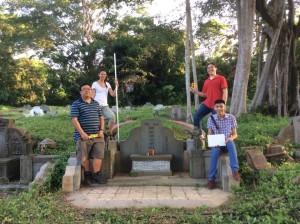
One for the album with the full team. Andrew on the left , Simone, Joshua and Wei Ming with his drawing, (photo Ee Hoon)
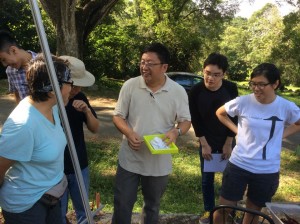
Dr Lai Chee Kien (third from left) sharing a light- hearted moment with his students (photo Ee Hoon)
***
Editors note
Documenting and taking precise measurements provide valuable data to analyze the proportions and variations through IT applications and ultimately relate it to Feng Shui. Tombstones are not just built, they are “feng shui’ed” Citizenry participation in a project like this is crucial because of the sheer size of Bukit Brown and because it signals a deeper engagement of ordinary people in wanting to understand all aspects of Bukit Brown. So kudos to Lai Chee Kien for this initiative and the first batch of participants for signing up. Hopefully there will be more.
What the tomb measurement workshop covered here.
For the first time Bukit Brown has been included in the Singapore HeritageFest with partners Singapore Heritage Society.
The walks are free but registration is needed via the Festival website only here
Registration opens 1 July, 2014. Spaces are limited so register early to avoid disappointment!
Bukit Brown in the City
Saturday July 19 & July 26, 4pm – 6.30pm
A number of pioneering settlers of 18th and 19th century colonial Singapore who were buried in the Chinese cemeteries of the Greater Bukit Brown Complex (including the first Chinese Municipal Cemetery) are today still remembered by streets and buildings bearing their name.
The activities and efforts of these movers and shakers – many of whom were members of leading Chinese families in other contemporary European colonies – contributed significantly to colonial Singapore’s transformation, from a regional entrepot port to a modern and globally significant trade and finance hub, the enterprise envisaged at its founding in 1819![]()
“Bukit Brown in the City” , takes you on a guided walk that covers Raffles Place; Boat Quay; Chulia Street (formerly Kling Road); Phillip Street; Telok Ayer Street; Club Street and eventually ending at Bukit Pasoh Road. Experience what life was like and what has changed over the years in old downtown Singapore.
The City in Bukit Brown
Sunday July 20th & 27th, 9am – 11.30am
Between 1922 and the period of the Second World War, a majority of the Chinese residents of Singapore were buried in Bukit Brown cemetery. Some of those buried here, were well-known and distinguished pioneers like Tan Ean Kiam; Gan Eng Seng; Tan Chor Nam; Lim Chong Pang; Tan Kheam Hock; Ong Sam Leong; Tan Boo Liat; See Tiong Wah – and they were leading contributors to the economic, social as well as cultural life of Singapore.
With “City in Bukit Brown”, we invite you to join the “Brownies” who will introduce you to the tombs of these prominent pioneers who landmarked street names and places all over Singapore. Listen to accounts of their lives, their fascinating backgrounds and the endearing legacies they handed down to our generation today.”
*****************************************************************************
About the Guides:
Alex Tan Tiong Hee, “Curator” and lead guide of “Bukit Brown in the City”
Alex, who studied law in England, was brought up on the lap of history. He was very close to his father, the late Tan Yeok Seong, who was a historian and scholar, as well as a publisher of educational textbooks for schools in Singapore. From his father was nurtured, an acute appreciation for the colonial history of Singapore vis-a-vis developments in China at that time Alex, lends to this heritage walk, his personal experience of historical places and the pioneers who are buried in Bukit Brown. Alex is an Executive Committee member of the Singapore Heritage Society.
The Brownies: The Brownies are the volunteers who have been spending their weekends conducting heritage walks at Bukit Brown since 2012. To date, over 11.000 people have visited Bukit Brown in organized walks. Inspired by positive responses from the public, the Brownies would like to spread and share the collective stories of the pioneers in Bukit Brown to the rest of the island. Chew Keng Kiat who is curating “The City in Bukit Brown” has conducted 120 guided walks at Bukit Brown.
More on the walks:
The Bukit Brown in the City and the City in Bukit Brown walks were specially curated for the Singapore Heritage Festival so as to storyboard a direct connection between two places – the City and the Cemetery. The former which stretches from the present Raffles Place to Club Street landmarks the commerce and business networks of our colonial past; the latter, the contributions of pioneers buried in Bukit Brown and our migrant history.
Many of the places within the city which served as offices for banks, shipping and trading houses no longer exist in their original physical form, but they are nonetheless still landmarked by the names of the pioneers who breathed life to them. The handful that still exist physically have been re-purposed to keep up with the times.
Consider “The Arcade” in Raffles Place and the connection with number 26 Boat Quay. The Arcade of yesterday was the offices of Guthrie; 26 Boat Quay – today “Penny Black” – was the business premises of Tan Kim Ching, eldest son of Tan Tock Seng. Both Guthrie and Tan Kim Ching were the builders of the Tanjong Pagar Dockyards – the precursor of what became the Port Authority of Singapore.
Some 10 doors away, 17 Boat Quay (present day OUB concourse) does not exist today, but back in the day it harbored a political fugitive from China. Kang You Wei was the architect of the failed movement to reform and stem the decline of the Imperial Qing from corruption and systemic abuse. The man who provided him refuge, Khoo Seok Wan, was an intellect and poet who inherited his father’s vast fortunes founded on rice trading of which number 17 was the office.
The City was more than just a place of commerce, it was a gathering of prevailing social, economic and political thought congregated at the Goh Loo Club, a gentlemen’s club, the last stop of the walk.
As such the walks are bespoke in nature, drawing on the personal as well as the broad strokes of the historical context of the life and times of the pioneers buried in Bukit Brown, and their web of connections as the elite of the day. But though elitist in make-up, it was their collective actions that had reflected their concerns for the larger populace and how to uplift their lot in life.
In contrast, with the City, the Cemetery has better withstood the test of time until plans were announced for an 8 lane highway which will slice it into half. As a burial ground for the Chinese from as far as back as the late 1800s, the Cemetery with 100,000 graves has been fertile ground for a group of volunteers called “Brownies”, who have been sharing what they have learned about the life stories of the pioneers in the City in their guided walks. The tomb of Tan Kim Ching is inscribed with Qing imperial titles as well as titles from Siam, Japan and Russia.
As a complementary to the City In Bukit Brown, the walk in the Cemetery is a gateway into another dimension of their life stories, the compelling inscriptions and the architecture of the graves.
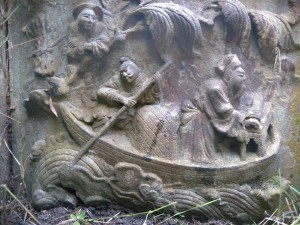

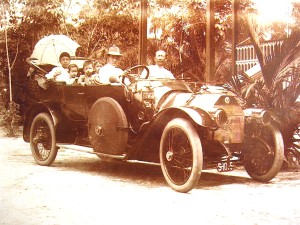
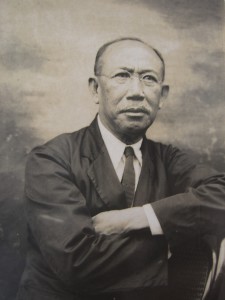
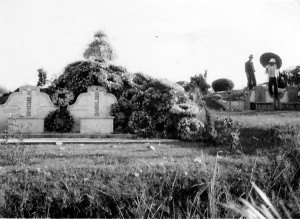

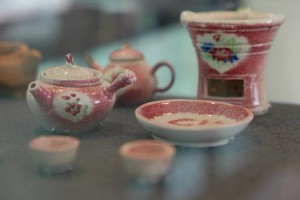


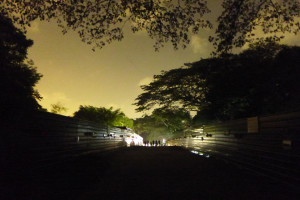
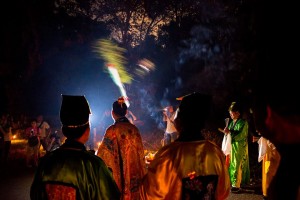

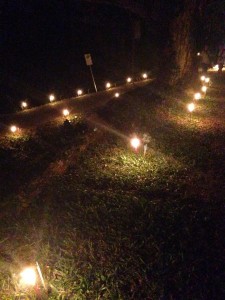
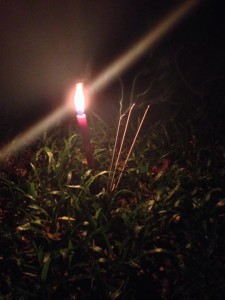
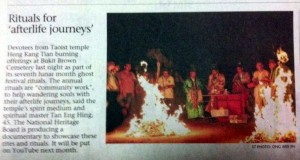
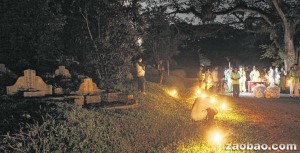
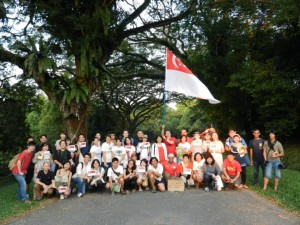
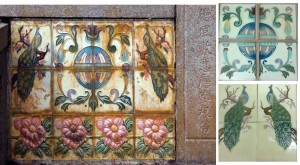
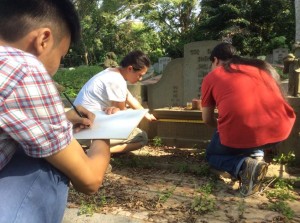
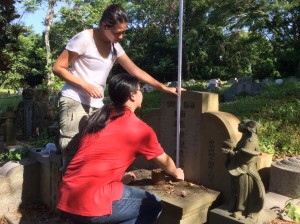


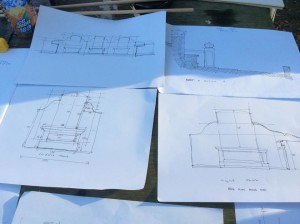
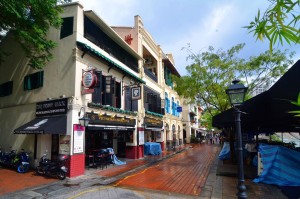

Recent Comments